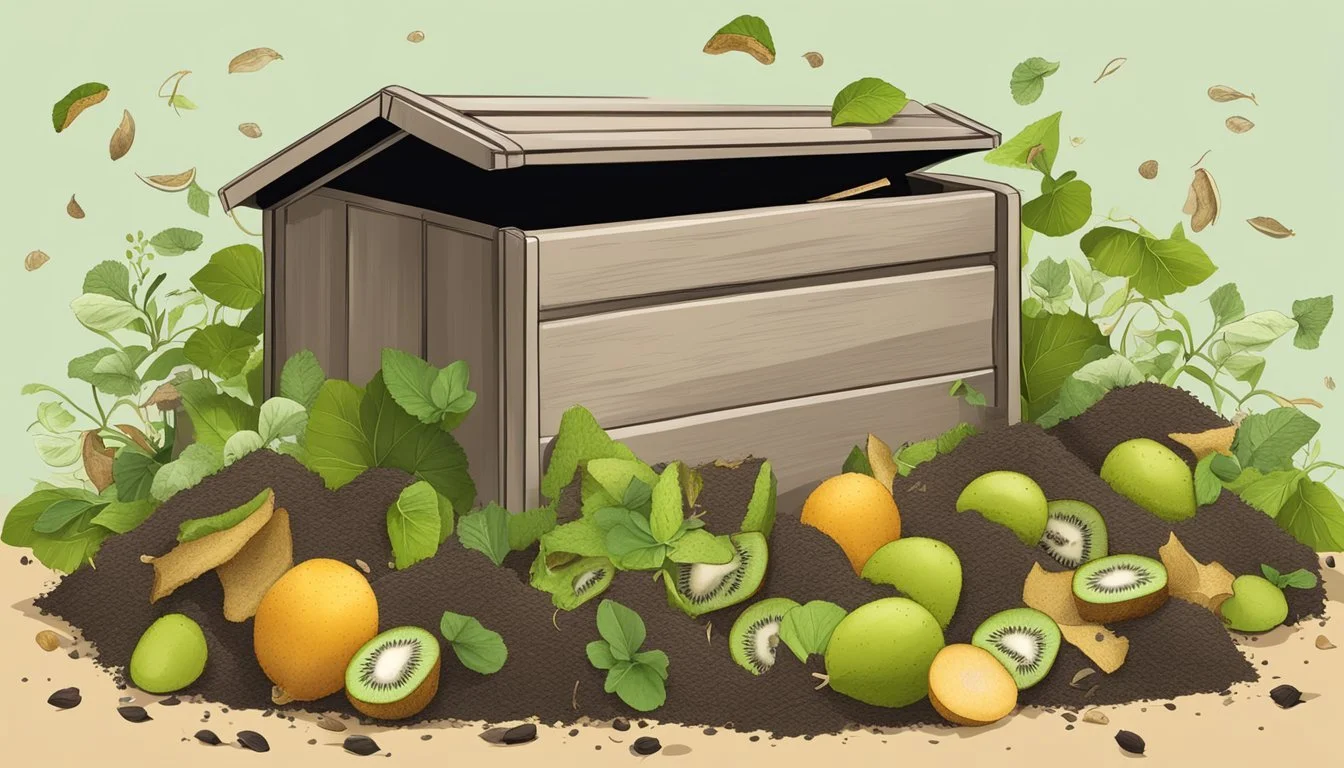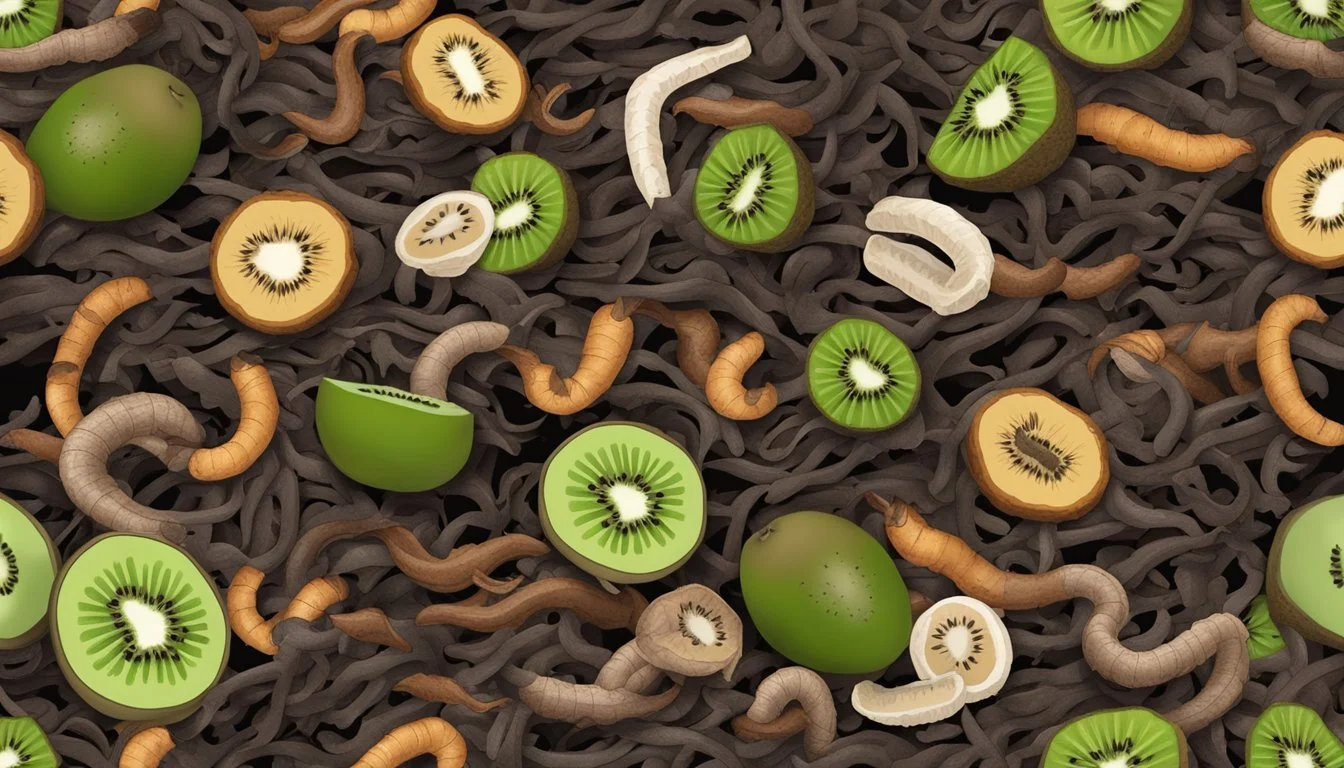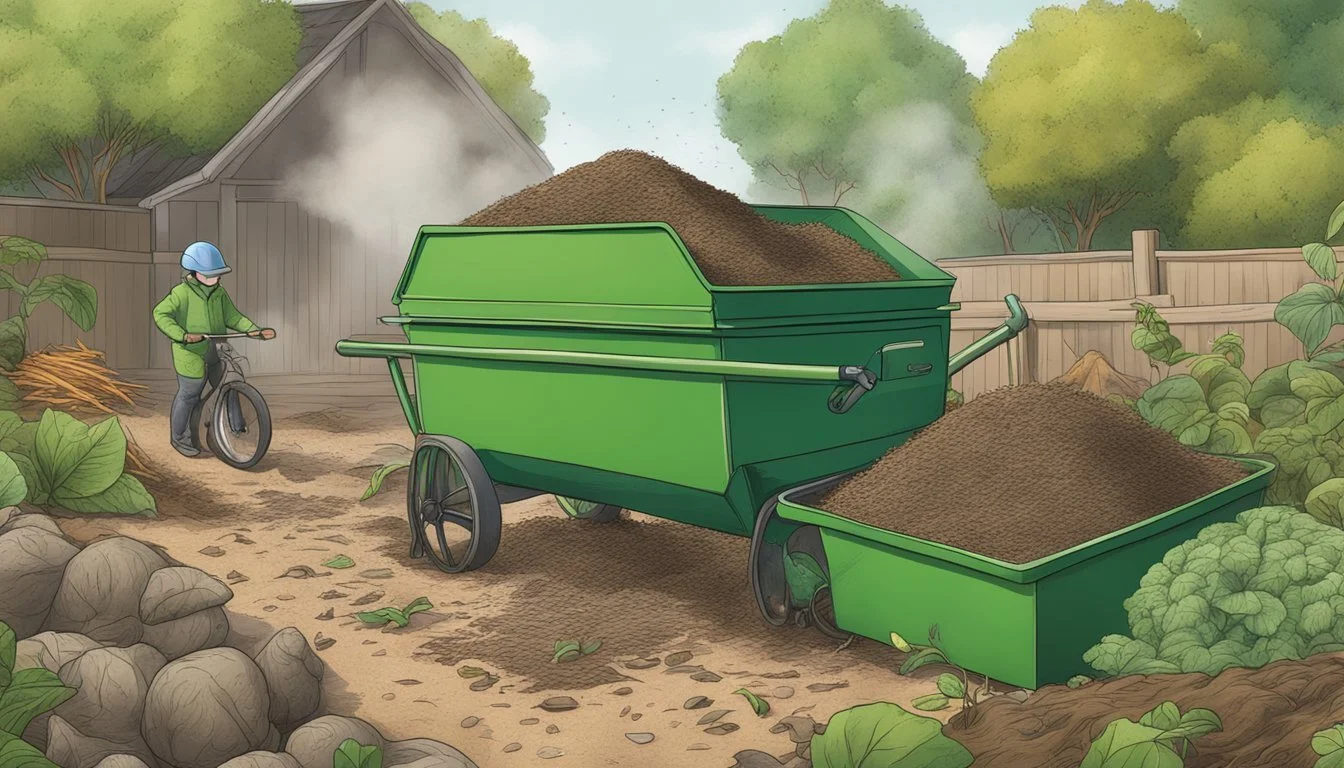Can You Compost Kiwi Hair?
Unraveling the Truth About Fruit Peel Composting
Composting is an effective method to recycle organic waste into nutrient-rich soil. As people look for more sustainable ways to dispose of various materials, questions often arise about what items are suitable for the compost bin. One such item is kiwi hair, the small, fibrous strands found on the skin of kiwi fruits.
They can add valuable nitrogen to a compost pile, which is essential for the microbial activity that breaks down organic matter. However, there are considerations to keep in mind when adding kiwi hair to compost, such as the potential introduction of non-organic substances like pesticides or the presence of fruit stickers that do not decompose.
While composting kiwi hair can contribute to a balanced compost mixture, it is essential to ensure that the kiwi skins are clean and free from any inorganic materials. Proper layering and moisture levels must be maintained in the compost pile to facilitate the breakdown of kiwi hair along with other green and brown composting materials.
Understanding Composting
Composting is a natural process that converts organic material into a rich soil amendment, providing a wealth of nutrients for plant growth while supporting environmental recycling efforts.
Basics of Composting
Composting requires three primary components: green waste (nitrogen-rich materials), brown waste (carbon-rich materials), and moisture. An effective compost pile should have a balanced mix of these components to facilitate the breakdown of materials into humus. The ratio of browns to greens should be roughly 30:1 by weight, ensuring a nitrogen-carbon balance that supports the activity of composting microbes.
Green Waste: Includes items such as fruit scraps, vegetable peels, and grass clippings.
Brown Waste: Encompasses materials like dry leaves, branches, and paper.
A consistent supply of oxygen through regular turning and adequate moisture are also essential. They maintain microbial activity and prevent the compost from becoming too wet or dry.
Benefits of Composting
Composting offers significant benefits for both the soil and the environment:
Soil Health: Compost enriches the soil with nutrients essential for plant growth and helps in soil structure improvement, promoting better water retention and aeration.
Environmental Impact: It reduces the amount of organic waste sent to landfills, minimizing methane emissions — a potent greenhouse gas.
Recycling Nutrients: By returning valuable nutrients to the soil, composting closes the nutrient loop and reduces the need for chemical fertilizers.
Incorporating compost into garden beds or as a top dressing can boost the soil's fertility over time, encouraging robust plant growth and contributing to a healthier ecosystem.
Composting Materials
When constructing a compost pile, it's essential to maintain a balance between 'green' nitrogen-rich materials and 'brown' carbon-rich materials, while avoiding harmful products to create fertile and effective compost.
Green Materials
Green materials provide necessary nitrogen, which is essential for the growth of microorganisms that break down organic matter. These materials typically have high moisture content and decay rapidly. Examples include:
Kitchen scraps: fruit and vegetable peels, coffee grounds, tea bags
Yard waste: grass clippings, plant trimmings
Compostable materials: such as kiwi hair, which is the thin, fibrous skin from kiwi fruits
Brown Materials
Brown materials are rich in carbon, which fuels the composting organisms and helps to maintain the necessary structure and aeration within the pile. They decompose slower than green materials, thus providing a steady supply of carbon. Examples include:
Dry leaves, straw, and sawdust
Cardboard, paper, and woody materials
It is critical to ensure a good balance of green and brown materials to maintain proper oxygen levels and moisture for effective composting.
Avoiding Harmful Products
To produce healthy and organic compost, it's vital to avoid materials that contain chemicals or are not compostable. Harmful products can kill the beneficial microorganisms or introduce toxins into the compost. They include:
Chemically treated yard waste: materials treated with pesticides or herbicides
Diseased plants: as they can spread pathogens to the rest of the compost
Food scraps: containing oils, fats, dairy, or meat products, which can attract pests and cause odor problems
Every compost pile should maintain the right mix of these elements to ensure successful decomposition and the creation of nutrient-rich compost.
The Role of Hair in Composting
Integrating hair into compost can contribute valuable nutrients to the soil, predominantly through its protein content and the action of decomposing microorganisms.
Types of Hair for Compost
Human hair and pet fur are both viable additives to compost. They are rich in protein and contain keratin, a tough and resilient form of protein that serves as a natural source of nitrogen. In particular:
Human hair: Typically collected from hairbrushes or salon waste, human hair can be added directly to compost.
Pet fur: Often gathered during pet grooming, this hair type can also be composted, especially from pets that are primarily outdoor animals, as it's less likely to have residue from grooming products.
It is essential that the hair is untreated, meaning that it has not been exposed to significant chemical treatments such as dyes or bleach, as these substances can be harmful to the microorganisms vital to the composting process.
Decomposition of Hair
The decomposition of hair in compost occurs through microbial activity. Bacteria and other microorganisms break down the hair over time, although the process can take several months due to the robust nature of keratin. The decomposition rate is influenced by the following factors:
Surface area: Hair should be spread thinly or mixed well within the compost to maximize surface exposure to microorganisms.
Moisture and warmth: A moist and warm compost environment accelerates the breakdown of hair.
Sulfur content: Hair contains sulfur, which is another nutrient beneficial to plants.
As hair decomposes, it slowly releases nitrogen, vital for plant growth, into the compost. However, due to the long decomposition time, hair should be considered a long-term amendment to compost rather than a quick fix. It's also noteworthy that the hair should be added in moderation to avoid excessive nitrogen levels, which could be detrimental to the composting process.
Specifics of Composting Kiwi Hair
Composting kiwi hair involves understanding its unique properties and how to properly integrate it into a compost pile to aid in the decomposition process.
Kiwi Hair Characteristics
Kiwi hair, commonly referred to as the thin fibrous strands or fuzz found on the outer skin of kiwi fruit, possesses characteristics that can influence compost quality. These fine fibers are biodegradable and can decompose, making them suitable for composting. They contain organic material that can support the microbial activity essential for breaking down compost ingredients.
Composition: Kiwi hair is primarily composed of natural fibers.
Decomposition rate: It breaks down at a moderate pace due to its structure.
Incorporating Kiwi Hair in Compost
To effectively incorporate kiwi hair into a compost bin, one should consider it a green ingredient—a source of nitrogen that microbes in the compost need to thrive.
Mixing ratio: Ensure a balanced compost by combining kiwi hair with brown ingredients, such as dried leaves or cardboard, to maintain an ideal carbon to nitrogen ratio.
Layering technique: Spread the kiwi hair in thin layers between other compost materials to prevent matting and to improve airflow, which is crucial for microbes to function effectively.
Moisture control: Since kiwi hair can retain moisture—which the compost pile needs for microbial activity—monitor the compost's moisture level regularly to ensure it remains damp but not waterlogged.
By integrating kiwi hair into the compost with consideration for balance and microbial needs, it contributes to a nutritious compost ideal for garden use.
Optimizing the Compost Process
Optimizing the composting process involves precise aeration and moisture control, thorough maintenance of the compost pile, and the ability to troubleshoot common issues effectively.
Aeration and Moisture Control
Proper aeration is crucial as it supplies the oxygen needed by bacteria to break down organic material. Turning the compost pile regularly ensures that air reaches the center. The pile should be moist, like a wrung-out sponge, to support microbial activity but not so wet that it becomes anaerobic. Moisture levels can be maintained by adding dry materials to overly moist compost or water to a dry pile to maintain balance.
Compost Pile Maintenance
Maintaining the compost pile includes monitoring the heat generated by the microbial activity. A hot pile will decompose materials faster but needs more frequent aeration. Regularly mixing the pile prevents the creation of odor and accelerates decomposition. If the pile is too cool, adding green materials rich in nitrogen can rekindle the composting process.
Troubleshooting Common Issues
Common issues in composting might include unpleasant odors, pests, or a slow composting process. These can often be resolved by adjusting the aeration or moisture levels. If a pile is too dry, it hinders bacterial activity and slows down composting - adding water and aerating can resolve this issue. Alternatively, if the pile is too wet and begins to smell, incorporating dry materials like straw or leaves will help absorb excess moisture and reduce odor.
Compost Bin Systems
When selecting a system for composting, it's essential to consider the types of compost bins available and the specific composting methods they are designed to support, such as traditional and tumbler bins as well as hot and cold composting systems.
Traditional vs Tumbler Compost Bins
Traditional Compost Bins are typically stationary and often have an open bottom that allows contact with the soil. These bins benefit from worms and microorganisms that naturally occupy the ground and aid in the decomposition process. They require manual turning of the compost, which involves a physical effort to introduce oxygen necessary for the composting process.
Benefits of Traditional Bins:
Encourages earthworm activity
Often utilizes household waste and garden clippings
In contrast, Compost Tumblers are designed as closed, elevated systems that one can rotate. This design promotes easier aeration as turning the tumbler introduces oxygen into the mix without the need for manual turning with a pitchfork or shovel.
Benefits of Tumbler Bins:
Simplifies the aeration process
Can speed up the composting process
Hot vs Cold Composting Systems
Hot Composting Systems invigorate the decomposition process to work at accelerated speeds by maintaining higher temperatures. These systems require a balanced mix of 'browns' (carbon-rich materials) and 'greens' (nitrogen-rich materials), as well as sufficient moisture and oxygen to foster the growth of thermophilic microbes. Hot composting piles can reach temperatures of up to 140-160°F and can turn organic matter into compost in as little as 18 to 28 days.
Characteristics of Hot Composting:
Requires careful balance of materials
Produces compost quickly
Cold Composting Systems are less intensive and generally comprise of piling up kitchen and garden waste and letting it decompose over a longer period, typically ranging from several months to a couple of years. A cold compost pile does not produce much heat and tends to decompose at a slower rate because it relies on fungi, bacteria, and the physical breakdown of materials over time.
Characteristics of Cold Composting:
Piles decompose without active management
Requires less frequent maintenance
Both systems benefit from the careful balancing of 'browns' and 'greens' to provide adequate carbon and nitrogen. The presence of oxygen is critical in both systems; in hot composting for fueling high-temperature decomposition and in cold composting to prevent the pile from becoming anaerobic and smelly.
Vermicomposting and Kiwi Hair
In vermicomposting systems, kiwi hair could serve as an adequate addition when used correctly, subject to examining its potential effects on the composting worms as well as the quality of the resulting compost.
Utilizing Worms in Composting
In vermicomposting, worms play a critical role by breaking down organic matter and converting it into nutrient-rich worm castings. The common practice involves adding kitchen scraps and yard waste into a worm bin, where worms — typically red wigglers — process the material. The essence of vermicomposting lies in maintaining a balanced environment, which means the right mix of 'greens' and 'browns' to provide both moisture and aeration.
Kiwi Hair as Worm Bedding
When considering kiwi hair for a worm farm, it's imperative to treat it as a 'green' component due to its nitrogen content. One must intersperse kiwi hair thinly to prevent matting and to ensure proper aeration within the worm bed. It’s crucial that kiwi hair is free of contaminants and is used sparingly, as excessive amounts could potentially alter the balance of the bin and harm the worms.
Environmental Impact
In the realm of waste management, composting kiwi hair plays a significant role in enhancing soil health and reducing the volume of organic waste in landfills. These actions are pivotal for sustaining a healthy environment.
Composting and Soil Health
Composting transforms organic matter like kiwi skins and hair into nutrient-rich humus. This process enriches the soil, increasing its ability to retain water and support the growth of healthy plants. It introduces beneficial microorganisms that help to break down organic matter, releasing essential nutrients such as nitrogen and phosphorus into the soil.
Nutrients supplied by compost:
Nitrogen
Phosphorus
Potassium
Micro-nutrients
The addition of composted materials like kiwi hair to the soil also helps to enhance its structure, aeration, and overall fertility, which are crucial for the long-term sustainability of agricultural practices.
Reduction of Waste in Landfields
Properly composting kiwi remnants including the furry skin contributes to a significant reduction of waste diverted to landfills. When organic matter decomposes anaerobically in landfills, it releases methane—a potent greenhouse gas.
Environmental benefits of composting kiwi hair instead of landfilling:
Reduces methane emissions from landfills
Lowers carbon footprint
Decreases the need for chemical fertilizers
Each contribution to the compost pile, including kiwi hair, takes a step towards a more sustainable waste management system. This process also aligns with the global movement to minimize the environmental impact associated with the disposal of organic waste.
Advanced Topics in Composting
Exploring the frontier of composting methods not only improves nutrient cycles but also contributes to sustainability. This section delves into the nuances of creating effective compost extracts and the latest breakthroughs in composting technologies.
Compost Tea and Extracts
Compost tea and compost extracts enhance plant growth and soil health through a liquid infusion of compost's beneficial microorganisms. Compost tea is created by steeping compost in water, which encourages microbial life. Compost extracts, on the other hand, are made by blending compost with water to create a quick-release, nutrient-rich liquid. Both are used to inoculate plant foliage and soil with a rich community of microbes.
Benefits of Compost Tea and Extracts:
Enhances plant disease suppression.
Provide immediate nutrients to soil and plants.
Increases microbial diversity in soil.
Application Method:
Foliar Spray: Applying compost tea to the leaves of plants.
Soil Drench: Pouring compost extracts directly into the soil around plants.
Research and Innovations in Composting
Cutting-edge research and innovations in composting seek to optimize the decomposition process and broaden the range of compostable materials, including hair from hairdressers and hair salons. Scientists focus on understanding the role of hair in compost digestion due to its high nitrogen content.
Innovative Practices in Composting Hair:
Studies on the digestion rate and pathogen suppression capability of hair in compost.
Development of special composting bins designed for hair salons.
Advances in composting technology are not only making the process more efficient but are also capturing valuable data that informs future best practices. Composting innovations improve our approach to organic waste management and have the potential to significantly impact environmental sustainability.








